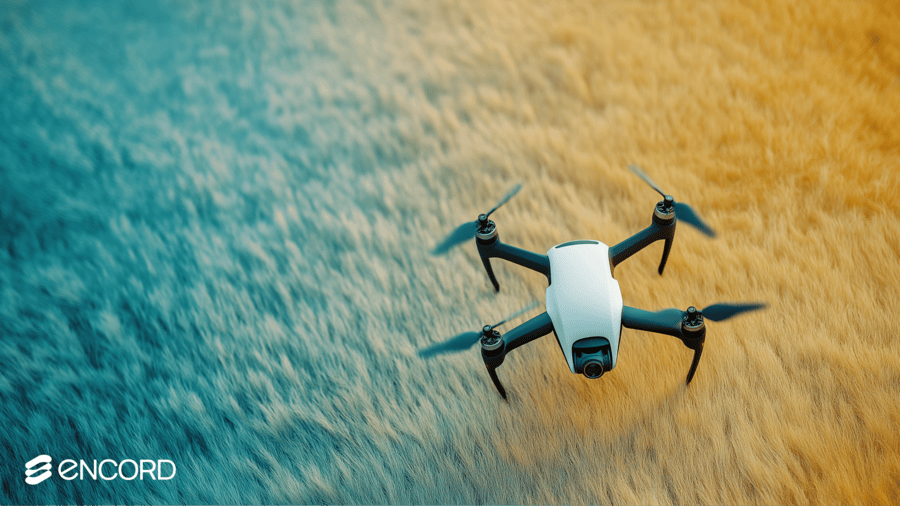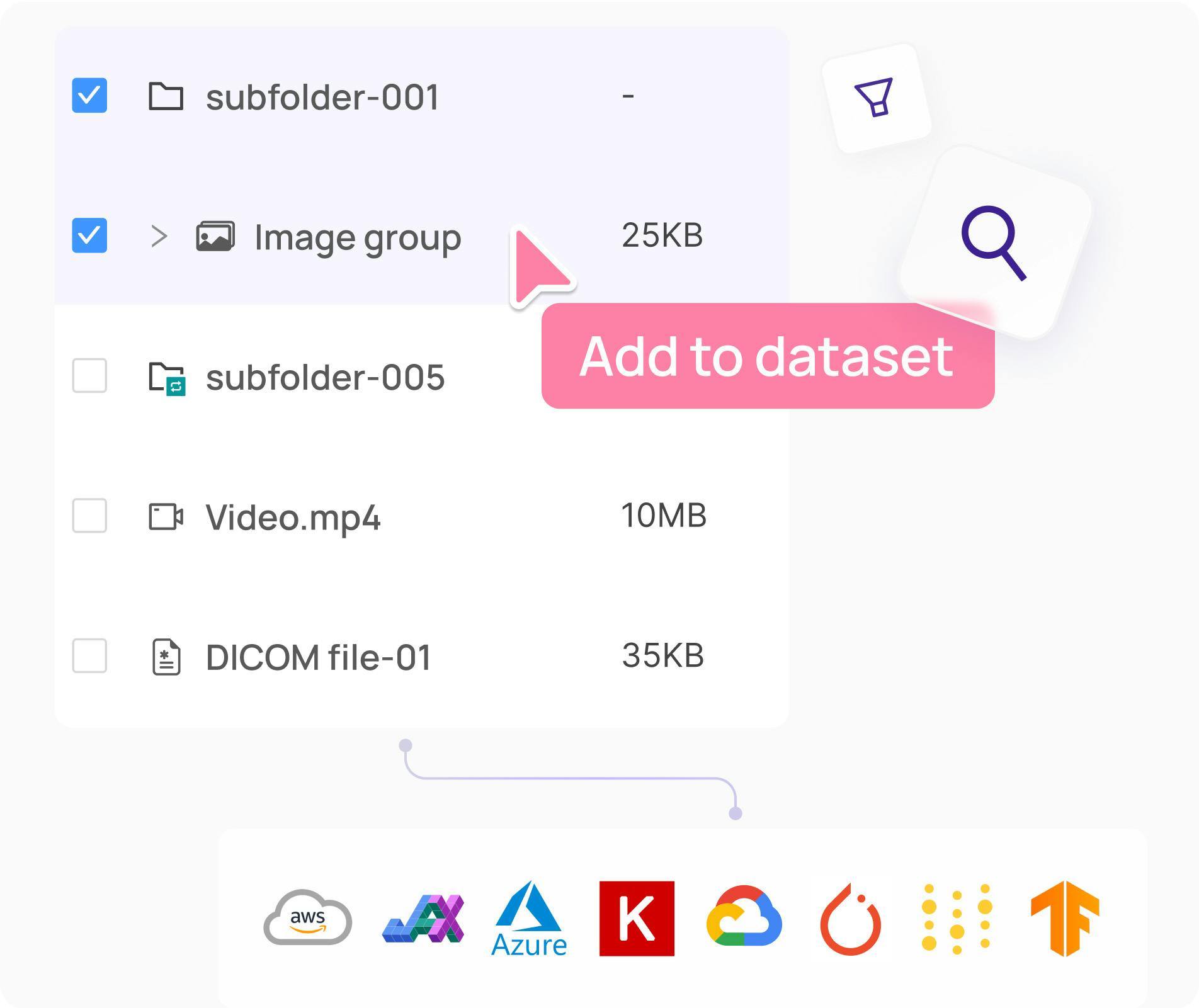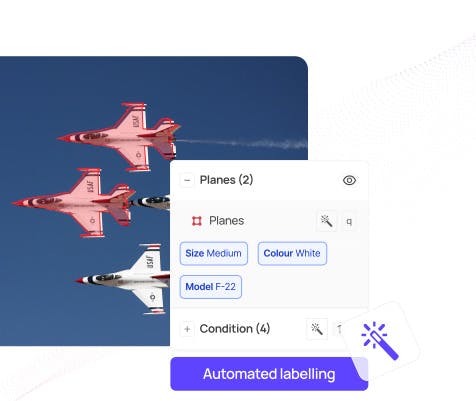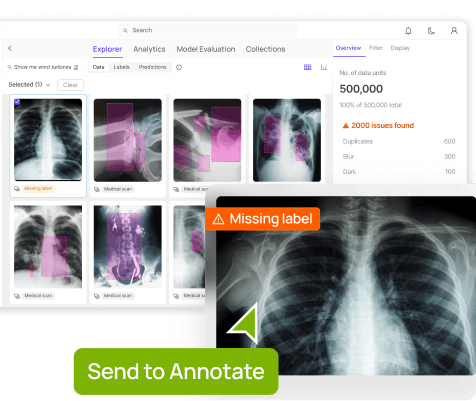Contents
What is an Agricultural Drone?
How Has the Agricultural Done Industry Transformed in the Past 5 Years?
Autonomous Agriculture Beyond Traditional Drones
Data and Tooling Requirements for Building Agricultural Robots
Challenges of Building Agricultural Robots
How Encord Helps Build Agricultural Drones: Conquering Data Challenges With a Data-Centric Platform
Key Takeaways
Encord Blog
Agricultural Drone: What is it & How is it Developed?
5 min read

With the world’s population projected to reach 9.7 billion by 2050, the demand for food is skyrocketing. However, farmers face unprecedented challenges due to labor shortages, climate change, and the need for sustainable practices. This is putting immense pressure on traditional farming methods.
For instance, manual weed control alone can cost farmers billions annually, while inefficient resource use leads to environmental degradation. Enter agricultural drones and robotics, a technological revolution set to transform farming as we know it.
Due to their significant benefits, the global agricultural drone market is expected to grow to $8.03 billion by 2029, driven by the urgent need for smarter, more efficient farming solutions. From AI-powered weed targeting to real-time crop health monitoring, these technologies are not just tools. They are the future of agriculture.
Yet, despite their potential, adopting these technologies poses a challenge. High upfront costs, technical complexity, and resistance to change often hinder widespread implementation.
In this post, we’ll discuss the data and tools required to build these systems, the challenges developers face, and how tools like Encord can help you create scalable robotic systems.
What is an Agricultural Drone?
An agricultural drone is an unmanned aerial vehicle (UAV) designed to assist farmers by automating crop monitoring, spraying, and mapping tasks. These drones, equipped with advanced sensors, GPS, and AI-powered analytics, capture high-resolution images, analyze soil health, and detect plant stress. Some models even perform precision spraying, reducing chemical usage and improving efficiency.
Benefits like automated takeoff and obstacle avoidance enable smooth operations in challenging farming environments. This saves time, lowers labor costs, and enhances yield predictions by providing real-time insights. Drones also allow farmers to perform precision agriculture, which helps them optimize resource use, minimize waste, and increase sustainability.

For instance, the DJI Agras T40, a leading spray drone, features advanced payload capabilities for effective crop protection. These machines help automate agricultural workflows and enable farmers to operate them via remote control for timely interventions.
How Has the Agricultural Done Industry Transformed in the Past 5 Years?
Over the past five years, agricultural drones have evolved from niche tools to essential components of precision farming. These innovations, driven by rapid technological advancements, regulatory support, and growing market demand, transform how farmers monitor crops, apply resources, and automate labor-intensive tasks.
Technological Advancements
The past five years have witnessed agricultural drones undergo significant technological evolution. Advancements in sensor technology, including multispectral and hyperspectral imaging, have enhanced the ability to monitor crop health with greater precision.
Battery life and propulsion system improvements have extended flight durations, allowing drones to cover larger areas in a single mission. Integration with artificial intelligence (AI) and machine learning (ML) algorithms has enabled real-time data processing.
These trends are leading to immediate decision-making for tasks like variable-rate application of fertilizers and pesticides to improve crop yields. Additionally, the development of autonomous flight functionality has reduced the need for manual intervention, making drone operations more efficient and user-friendly.
Regulatory Framework
The regulatory landscape for agricultural drones has become more structured and supportive. Many countries have established clear guidelines for their use, addressing issues such as airspace permissions, pilot certifications, and safety standards.
For instance, the Federal Aviation Administration (FAA) in the United States has implemented Part 107 regulations, providing a framework for commercial drone use, including agriculture. These regulations have streamlined the process for farmers and agribusinesses to adopt drone technology, ensuring safe and legal operations.
Collaborations between regulatory bodies and industry stakeholders continue to evolve, aiming to balance innovation with safety and privacy concerns.
Market and Industry Growth
The agricultural drone market has seen significant growth. Currently, the market is approximately $2.41 billion, with projections estimating a size of $5.08 billion by 2030. This trend means a compound annual growth rate of 16% from 2025 to 2030.

This expansion is mostly driven by the need for automated farming operations in the face of labor shortages in the agriculture industry. Farmers are recognizing the return on investment that drones offer through enhanced crop monitoring, efficient resource utilization, and improved yields.
Top Companies in the Space
Several companies are leading the agricultural drone revolution, developing advanced drone solutions that enhance precision farming. DJI, a dominant force in the drone industry, has introduced cutting-edge models tailored for agriculture. The Mavic 3M, a multispectral imaging drone, enables farmers to monitor crop health accurately. This drone uses Real-Time Kinematics (RTK) technology for centimeter-level positioning.
For large-scale operations, DJI Agras T50 and T40 drones offer robust crop spraying and spreading capabilities, allowing for efficient pesticide and fertilizer application. These drones integrate AI-powered route planning and RTK positioning to ensure precise operations and minimize environmental impact.
Beyond DJI, Parrot has developed drones with high-resolution imaging capabilities tailored for agricultural use. For example, the Parrot Bluegrass Fields provides in-depth crop analysis and covers up to 30 hectares with a 25-minute flight time.
AgEagle Aerial Systems, known for its eBee Ag unmanned aerial system (UAS), offers aerial mapping solutions to help farmers make data-driven decisions. Meanwhile, XAG, a rising competitor, specializes in autonomous agricultural drones. One example is the XAG P100, which integrates AI and RTK technology for precise spraying and seeding.
Such companies are shaping the future of smart agriculture by combining automation, high-resolution imaging, and advanced navigation.
Case Study from John Deer
John Deere has been at the forefront of integrating autonomous technology into agriculture. In 2022, the company introduced its first autonomous tractor, which has since been used by farmers across the United States for soil preparation.
Building on this success, John Deere plans to launch a fully autonomous corn and soybean farming system by 2030. The system will address labor shortages and enhance productivity.
The company's latest Autonomy 2.0 system features 16 cameras providing a 360-degree view and operates at flight speeds up to 12 mph, a 40% increase over previous models. John Deere seeks to improve agriculture efficiency, safety, and sustainability by automating repetitive tasks.
Autonomous Agriculture Beyond Traditional Drones
Agricultural drones have transformed how we monitor crops and spray, but the next evolution lies in autonomous agriculture robotics. These systems go beyond aerial capabilities, incorporating ground-based robots that carry out tasks such as planting, weeding, and harvesting with unmatched precision.
The transition from drones to robotics represents a natural progression in precision agriculture. Drones are excellent for aerial data collection and spraying, but ground-based robots can manage more complex, labor-intensive tasks.
For example, robots with computer vision and AI can identify and remove weeds without damaging crops, reducing herbicide use by up to 90%.
Robots like FarmWise’s Titan FT-35 use AI to distinguish crops from weeds and mechanically remove invasive plants. Laser-based systems, such as Carbon Robotics’ LaserWeeder, eliminate weeds accurately, saving farmers thousands in herbicide costs.
Additionally, Ground robots with multispectral cameras and sensors can monitor soil moisture, nutrient levels, and plant health in real time. Robots like Ecorobotix’s ARA analyze soil composition and apply fertilizers with variable-rate precision, ensuring optimal nutrient delivery.
Data and Tooling Requirements for Building Agricultural Robots
Developing agricultural robots requires a comprehensive approach to data and technology. The process begins with collecting high-quality, relevant data, which forms the foundation for training and refining the AI models that enable autonomous operation in agricultural fields.
Data Collection
Data collection is the most critical aspect of developing agricultural robots. The data must come from various sources to capture the complexity of agricultural environments. This includes real-time data from sensors embedded in robots or placed across fields to measure soil moisture, temperature, pH levels, and nutrient content.
Cameras and multispectral sensors capture detailed imagery of crops, allowing for analysis of plant health, growth stages, and pest presence. Historical data, including weather patterns, previous crop yields, and soil health data, adds layers of predictive capability to AI models.
AI and ML Platforms
The "brains" of agricultural robots consist of AI and ML algorithms, which require powerful software tools and platforms. These platforms help create and train intelligent models that enable robots to perceive, understand, and act in agricultural environments.
Machine Learning and Computer Vision Frameworks
ML platforms like TensorFlow and PyTorch train AI models that allow image recognition for weeding and disease detection. Additionally, specialized frameworks from NVIDIA for GPU acceleration enhance speed.
OpenCV, an open-source CV library, offers a collection of algorithms for image processing, feature extraction, object detection, video analysis, and more. It is widely used in robotics and provides essential building blocks for vision-based agricultural robot applications.
Robotics Middleware and Frameworks
ROS (Robot Operating System) is a widely adopted open-source framework for robotics software development. It simplifies sensor integration, navigation, motion planning, and simulation. Key features include:
- Sensor integration and data abstraction: Provides a unified interface for accessing and processing sensor data.
- Navigation and localization: Offers pre-built algorithms, mapping tools, and localization techniques (e.g., SLAM) for autonomous robot navigation.
- Simulation Environments: ROS integrates seamlessly with simulation environments like Gazebo. It enables developers to test and validate robot software in a virtual world before deploying it to real hardware.
Edge AI Platforms
NVIDIA Jetson embedded computing platforms (e.g., Jetson AGX Orin, Jetson Xavier NX) are widely used in robotics to balance performance and energy efficiency. They provide potent GPUs and execute complex AI models directly on robots in real-time.
Google Coral provides edge TPU (Tensor Processing Unit) accelerators that are specifically designed for efficient inference of TensorFlow Lite models. Coral platforms are cost-effective and energy-efficient. This makes them suitable for deploying lightweight AI models on robots operating in power-constrained environments.
Hardware Considerations and Software Integration Requirements
Selecting the appropriate hardware is equally important because the physical environment of a farm is harsh and unpredictable. Robots must be designed to withstand dust, water, extreme temperatures, and physical shocks.
This requires selecting durable materials for the robot's body, ensuring that sensors and cameras are both protected and functional. It is also important to choose batteries that provide long life and fast recharge capabilities.
The software must also be robust and capable of managing diverse data inputs, processing them efficiently, and sending commands to the robotic systems. Additionally, the software should integrate seamlessly with existing farm management software, Internet-of-Things (IoT) devices, and other agricultural robots or drones for an effective farm management solution.
Challenges of Building Agricultural Robots
Despite the advantages of deploying agricultural robots, several challenges stand in the way of their widespread adoption and effective operation.
- Environmental factors: Agricultural robots face challenges due to unpredictable environments, including rough terrain, mud, and severe weather, which can affect their sensors and mobility systems. Hyperspectral cameras and LiDAR often fail in fog or low-light conditions, reducing data accuracy.
- Regulatory constraints: Varied regulations across regions can limit operational areas and require certifications. Additionally, they impose data privacy and usage restrictions, complicating operations.
- High initial costs: Significant upfront costs are associated with research, engineering, and software development. High-performance components contribute to expensive robot systems. Collecting and labeling large datasets for AI training is resource-intensive.
- Data quality: Robots rely on high-quality data for disease detection and yield prediction tasks. However, bias in training data poses challenges, such as models trained on monoculture farms failing in diverse cropping systems. Additionally, annotating crop imagery for ML requires precise tagging of subtle features, which is time-intensive and error-prone.
- Maintenance: Regular maintenance is necessary in harsh agriculture, but it can be logistically challenging and costly, particularly in remote or expansive farming areas.
How Encord Helps Build Agricultural Drones: Conquering Data Challenges With a Data-Centric Platform
As we discussed, building efficient agricultural robots presents numerous challenges, mainly due to the inherent complexities of agricultural data. Agricultural sensor data is often noisy and imperfect due to environmental factors. Human annotation can introduce errors and inconsistencies, which can impact model accuracy.
These data quality challenges can greatly hinder developing and deploying effective agricultural drone and robot systems.
Recognizing that quality data is not just a component but the cornerstone of successful AI, platforms like Encord are specifically designed to address these critical data challenges.
Encord provides a comprehensive, data-centric environment tailored to streamline the AI development lifecycle for CV applications in demanding fields like agricultural drones and robotics.
It also enables effective management and curation of large datasets while facilitating the iterative improvement of model performance through intelligent, data-driven strategies. Below are some of its key features that you can use for agricultural drone development.
Key Takeaways
Agricultural drones are transforming farming by enabling precision agriculture, reducing labor costs, and optimizing resource use. With advancements in AI and automation, these drones are becoming more efficient and accessible. Governments are supporting adoption through regulations, and the market is expected to grow significantly. Beyond drones, ground-based robotics are shaping the future of fully autonomous farming, driven by data and AI-powered analytics.
Explore the platform
Data infrastructure for multimodal AI
Explore product
Explore our products
- Agricultural drones are used for crop monitoring, spraying fertilizers and pesticides, mapping fields, and assessing soil health. They help farmers improve efficiency, reduce costs, and optimize resource use.
- These drones are equipped with advanced sensors, GPS, and AI-powered software. They capture high-resolution images, analyze crop health, and execute precision spraying to minimize waste.
- Agricultural drones save time, reduce labor costs, improve yield predictions, and enable precision agriculture. They also help minimize environmental impact by reducing chemical usage.
- High upfront costs, technical complexity, regulatory compliance, and resistance to change are common barriers to widespread adoption.
- Developing agricultural robots requires high-quality sensor data, AI and ML platforms (such as TensorFlow and OpenCV), robotics middleware like ROS, and robust edge computing platforms like NVIDIA Jetson and Google Coral.


